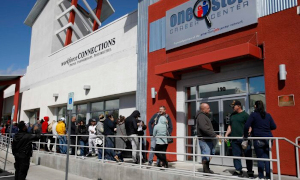This article was published at The Epoch Times here.

The jobless claims figures of the past two weeks have been unprecedented and alarming. However, knowing that the data will continue to be concerning, we need to analyze how quickly the economy can can heal and go back to the previous path of record job creation.
The United States economy starts from a comparatively stronger base. Unemployment reached a five-decade low in February and, despite the extremely weak March jobs figure, it stood at 4.4 percent in the first week of April. This compares to a 7.3 percent unemployment figure in the euro area and 6.5 percent in the European Union. In countries such as Spain and Greece, unemployment stood at 13 percent and 16 percent, respectively.
The underemployment figure is also significantly better in the United States. The unadjusted U-6 unemployment rate measure was 8.9 percent in March, and a comparable underemployment rate in the European Union would be an estimated 15 percent, and 12 percent in the eurozone, according to Eurostat figures.
The expected rise in unemployment from the forced shutdown of major economies due to COVID-19 containment measures is simply staggering. The International Labor Organization reported that potential job losses worldwide could amount to 36 million. Unfortunately, this figure may be underestimated.
The figure of unemployed in the second quarter of 2020 in the United States could rise to 52 million, a 32 percent unemployment rate, according to the Federal Reserve Bank of St. Louis. In Spain alone, the figure could rise by 5 million, and reach an unemployment rate of 35 percent in our estimates, while temporary and full unemployed could rise to 57 million in the European Union.
The key to a strong recovery lies in the dynamism of the labor market and the strength of the business fabric, but also on a diversified and open mechanism of financing of the real economy.
The United States could recover the entire job losses of a month in a period of one to three months. In the eurozone, this would take a minimum of five to six months, particularly in Germany, which also started the shutdown crisis with an all-time low unemployment rate, at 3.2 percent. Considering countries with higher labor market rigidity, such as Greece, Spain or Italy, this recovery could take between 14 months and two years.
The key to recovering jobs quickly and efficiently is the combination of a flexible labor market, an attractive investment framework, and solid policies to preserve the business fabric of the country. These are the main reasons why the United States traditionally reduces unemployment faster and with better wage growth than the eurozone.
There’s also the issue of disincentives. In the eurozone, excessive intervention in the labor and business environment adds to many entitlement programs that may be counterproductive in a recovery. The European Union spends about 1 percent of GDP per year in “active employment programs” and subsidies, yet the unemployment rate is almost double that of leading economies.
Excessive regulation works as a barrier to investment and job creation in growth times and generates negative incentives to recover after crisis periods. This was evident during the last crisis. The European Union delayed its recovery by four years due to the increased intervention and regulatory hurdles.
The financing mechanism is also key. In the United States, the real economy relies less on bank financing than in most of Europe. The real economy dependence on bank financing in the European Union is close to 80 percent, according to the European Central Bank, compared to 17 percent in the United States, according to the Federal Reserve Board.
This dynamism and openness in financing of business opportunities has traditionally helped the United States boost its economic recovery from a recession, achieving faster growth and more job creation than its peers.
An attractive taxation system is essential to recovering quickly. Unfortunately, in the European Union governments tend to raise taxes on businesses and capital in recession periods, which significantly hurts the recovery process. Legal and investment security are also fundamental in a sustainable and rapid recovery, and, unfortunately, interventionist messages coming from governments generate less inflow of foreign investment and lower growth in gross capital formation.
The recent decision of the Italian and Spanish governments to make dismissals forbidden by law and to intervene in prices will likely prove ineffective, as unemployment will soar anyway due to the destruction of businesses forced to close and will likely harm future investment inflows.
Shutting down the economy may cause long-lasting damage to job creation and businesses that can’t be unwound in a few months; that’s why it’s essential to contain the virus spread with effective measures, but we can’t forget that each month of lockdown means millions of unemployed and thousands of business closures.
The best course of action to tackle the health crisis, as well as the economic collapse risk, is to follow the South Korea and Singapore strategy, which is to implement strict prevention and testing measures, preserve the business fabric, provide safety equipment and health protocols for businesses to survive, and ensure that the economy continues to work while controlling the health crisis.
We can’t forget the difficult time that millions of workers and thousands of businesses are going through, and that’s why it’s imperative for governments to preserve the business fabric to avoid an economic depression of long-lasting social consequences.
The United States can recover the recent dramatic jobless figures in a few months if the government tackles the health crisis effectively and prevents an economic depression.
Health and jobs are not mutually exclusive. The United States will recover faster and stronger if the government puts both as the main objectives of policy.
Daniel Lacalle, Ph.D., is chief economist at hedge fund Tressis and author of “Freedom or Equality,” “Escape from the Central Bank Trap,” and “Life in the Financial Markets.”